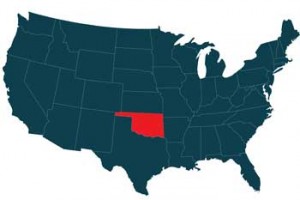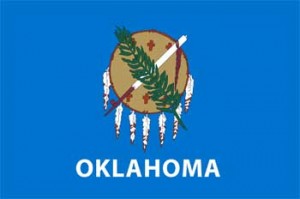Oklahoma Emergency Vehicle Light State Statutes
 “Red is one of the strongest colors; it's blood, it has a power with the eye,” said artist Keith Haring. It is little wonder then that one of the strongest signals on roadways is a flashing red light, which is one reason Oklahoma state law strictly controls how red lights and other color emergency vehicle lights are employed. The following is an overview of the use of lights on various types of vehicles in the state.
“Red is one of the strongest colors; it's blood, it has a power with the eye,” said artist Keith Haring. It is little wonder then that one of the strongest signals on roadways is a flashing red light, which is one reason Oklahoma state law strictly controls how red lights and other color emergency vehicle lights are employed. The following is an overview of the use of lights on various types of vehicles in the state.
Emergency Vehicles
Oklahoma statutes require that all authorized emergency vehicles have lights colored blue or red and that flash. These units may also use instead a light system that employs both colors. It is required that the lights be visible to approaching motorists at least 500 feet away. (Oklahoma Statute § 47 12-218)
Police Lights
All authorized law enforcement vehicles in Oklahoma are required to have red or blue lights that flash. Law enforcement agencies are also allowed to use a combination light set up that includes both red and blue lights that flash. These police lights must be able to be seen at a minimum distance of 500 feet in daylight conditions. There are some exceptions to this rule for an unmarked law enforcement vehicle. An unmarked vehicle must have a specific set of colored lights in exact locations on the vehicle. The following is a brief description of these specific rules:
Front – It must have three lights that flash. The color of the lights must be red or blue. The unit also may use lighting equipment that employs both blue and red lights that flash. These lights must shine forward from the vehicle. State regulations also require that the vehicle have two flashing white lights that shine forward from the unit.
Corner - The vehicle must also have special emergency lighting attached to its corners. The color of these corner lights must be red, blue, or white. Lighting equipment that combines all three of these colors may also be used on the corners. The vehicle must be so equipped that it will be visible from any angle in a 360 degree field of vision.
Rear – The vehicle must have at least one red, blue and amber light that flashes attached to the back of the unit which shines to the rear. A light configuration that combines these three colors is also allowed.
(Oklahoma Statute § 47 12-218)
Fire Truck Lights
Oklahoma State Statute 47-12-218(a) requires fire trucks, along with other emergency vehicles to have lights that are red or blue in color and that flash. These vehicles may also use a lighting set-up that combines these two colors. Motorists must be able to see these fire truck lights from at least 500 feet away when they are flashing.
(Oklahoma Statute § 47 12-218)
Volunteer Firefighter Lights
In 2013, Oklahoma statutes were modified to allow a volunteer firefighter to operate a private vehicle equipped with emergency lights colored red or white that flash. A lighting system that employs both colors in combination is also allowed. The only requirement to use such lighting is that the individual must have the authorization of the local fire chief. State law authorizes the local chief to decide if volunteers may equip their vehicles as such. The volunteer firefighter must have a written authorization letter signed by the local chief and carried in the vehicle at the time of use. As with other emergency vehicles, the lights must be visible from 500 feet away during the daytime.
(Oklahoma Statute § 47 12-218.3)
Ambulance Lights
Ambulances in the state are required to have either blue or red lights that flash. These lights must also be seen at least 500 feet away during the daytime. They may also have the option of having any combination of red and blue flashing lights, as long as they have the same visibility.
(Oklahoma Statute § 47 12-218[a])
Tow Trucks Lights
 All licensed wreckers must have a minimum of one rotating or flashing amber light that is visible to approaching motorists from any angle 360 degrees. The light may be positioned on a light bar. The amber light is to be used when the wrecker is working at the location of an roadside emergency or to warn other motorists of a traffic hazard. Though additional lighting is not required, a wrecker is allowed to also have a blue or red light that flashes. The wrecker may also use a lighting system that includes both blue and red lights that flash.
All licensed wreckers must have a minimum of one rotating or flashing amber light that is visible to approaching motorists from any angle 360 degrees. The light may be positioned on a light bar. The amber light is to be used when the wrecker is working at the location of an roadside emergency or to warn other motorists of a traffic hazard. Though additional lighting is not required, a wrecker is allowed to also have a blue or red light that flashes. The wrecker may also use a lighting system that includes both blue and red lights that flash.
The color of strobe lights a tow truck may be use depends on the location of the vehicle. At the scene of an emergency, the vehicle may use blue or red lights that flash. It may also use a light system that flashes both colors instead. When leaving the location of a place of service, the vehicle may use a flashing amber light that is visible from a minimum of 500 feet from the vehicle. The vehicle may also use the amber light to warn approaching vehicles to proceed cautiously in passing or overtaking the wrecker. The wrecker is never to use the blue or red lights that flash once it pulls out onto the road to transport a damaged vehicle.
(Oklahoma Statute § 595:25-5-2)
(Oklahoma Statute § 47:12-218.1)
Construction Vehicle Lights
The lights allowed on construction vehicles are governed by the entity which operates the vehicle. The following is a brief description for each category:
Vehicles/machinery owned by state, county, or city agencies
These vehicles may only have amber colored lights that flash. These lights must meet standards and specification set by the national professional organization for state officials who oversee highways.
Vehicles owned/operated by Oklahoma Department of Transportation or Oklahoma Turnpike Authority
These vehicles or pieces of machinery may be equipped with lights colored blue or red and that flash. The lighting system must be mounted so that it shines to the read of the unit. County vehicles or equipment that is engaged in emergency work or in highway construction/maintenance may also have blue or red lights that flash and shine to the back of the vehicle.
(Oklahoma Statute § 47-12-229)
Utility Vehicle Lights
As a maintenance vehicle, a public utility vehicle owned or operated by a state, county, or city agency may have an amber colored light that flashes. The light is only allowed to be used when it is performing emergency work.
(Oklahoma Statute § 47-12-229)
Pilot Vehicle Lights
Commercial vehicles which accompany oversized loads as “pilot” cars are required by Oklahoma state law to have a light that can rotate or flash. It must be amber in color. A light bar with amber colored lights is also allowed. The light must be visible at 500 feet and be a minimum of 10 inches in diameter and 8 inches tall. The lights may only be used when actually escorting a vehicle.
(Oklahoma Statute § 595:30-3-17)
Security Vehicle Lights
Under Oklahoma law, private security company vehicles may have overhead revolving or strobe lights and rear amber deck lights, and dashboard revolving or strobe lights.
(Oklahoma Statute § 390:35-5-2)
"Safety doesn't happen by accident," observed a wise man. For that very reason, the Oklahoma state laws closely govern the use of emergency lights on vehicles - to keep the public safe on state roads.
For more information about what lights may be available to you, we suggest calling your State Highway Patrol office at: 405-521-6040
*Please note that these numbers are what we are currently able to find and the numbers may have changed since this listing.
Disclaimer: The emergency vehicle light state statute guide was created by Extreme Tactical Dynamics as a guide and reference. We make no claim to the accuracy or validity of this guide. This guide was written to the best of our knowledge and has been provided to our customers as a courtesy ONLY! The information in this guide is our interpretation of the law as we have read it. We cannot be held responsible for any errors as this is only our interpretation of the law and the laws are constantly changing. We cannot be held liable or responsible for any errors and recommend that our customers refer to their local authorities to confirm the particular statue that governs their use of emergency vehicle lights.
 Facebook
Twitter
Google+
Instagram
YouTube
Facebook
Twitter
Google+
Instagram
YouTube


